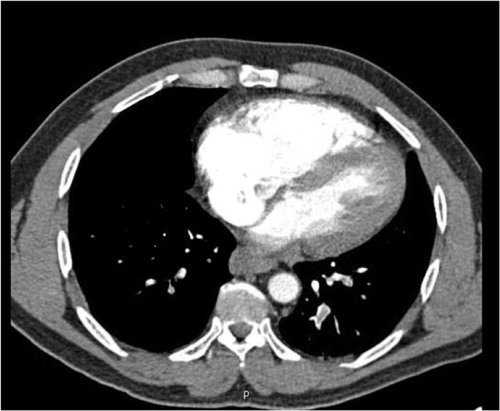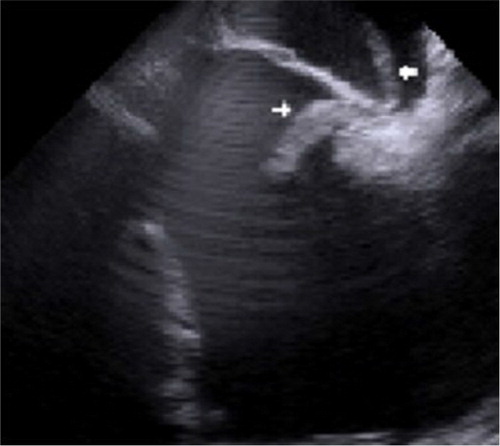Abstract
In rare cases, thrombus in transit can be entrapped in a patent foramen ovale (PFO). A patient with this condition is at high risk of embolic stroke and death. Early diagnosis and treatment is essential to help prevent stroke and death in these cases. There is no universal management guideline for this rare condition. The decision between medical versus surgical treatment should be made individually for each patient. We present a case of thrombus in transit entrapped in a PFO that was treated medically by lifelong anticoagulation.
Thrombus in transit is an uncommon form of venous thromboembolism (Citation1). Usually the thrombus is located in the right heart, but in rare situations it can travel to the left atrium through a patent foramen ovale (PFO) (Citation2). We present a case in which a large embolus was lodged in a PFO.
Case presentation
The patient is a 46-year-old African American male with a history of stroke, diabetes, and HIV, who presented with a sudden onset shortness of breath, palpitations, and chest discomfort. He was taking aspirin, clopidogrel, pravastatin, and anti-HIV medication. His family history was negative for any clotting disorders. Physical examination was unremarkable except for tachycardia and right-sided weakness associated with an episode of stroke 10 years earlier. EKG showed only sinus tachycardia. CT chest angiography demonstrated a large bilateral pulmonary embolism (PE) with straightening of the interventricular septum suggesting right heart strain (). Intravenous heparin was started immediately. Right heart strain necessitated a transthoracic echocardiogram (TTE) that showed a possible thrombus versus mass in both atria. To confirm the diagnosis, a transesophageal echocardiogram (TEE) was done. The TEE showed a PFO with a large thrombus measuring 10 cm lodged in the PFO (). Of note, a TEE with bubble study, which was done as part of the previous stroke workup, did not show any right-to-left shunt. Cardiac surgery was consulted for possible surgical removal of the thrombus and repair of the PFO. After a discussion of the risks and benefits of surgical versus medical management, the patient chose not to undergo surgery. He was bridged from heparin to lifetime warfarin to help prevent another stroke. A year later, follow-up TTE did not show a PFO or any clot in the heart. He has not had any new thromboembolic event at over 1-year follow-up.
Discussion
The mortality rate in cases of PE with thrombus in transit is very high (Citation1). Early diagnosis and treatment is of utmost importance in these cases. There is no general consensus about the best treatment for a thrombus entrapped in a PFO (Citation2). Because of the high risk of death from thrombus in transit, a cardiothoracic surgeon should be consulted immediately upon confirming the diagnosis (Citation3). If the PFO is not repaired, the patient should remain on anticoagulation indefinitely (Citation4). This case is also a reminder that a negative TEE does not rule out the presence of a PFO (Citation5). If the clinical suspicion for PFO is high, another TEE should be performed.
Conflict of interest and funding
The authors have not received any funding or benefits from industry or elsewhere to conduct this study.
Acknowledgement
The authors thank Lyn Camire, MA, ELS, for editorial assistance.
References
- Chartier L, Bera J, Delomez M, Asseman P, Beregi JP, Bauchart JJ, etal. Free-floating thrombi in the right heart: diagnosis, management, and prognostic indexes in 38 consecutive patients. Circulation. 1999; 99(21): 2779–83.
- Baydoun H, Barakat I, Hatem E, Chalhoub M, Mroueh A. Thrombus in transit through patent foramen ovale. Case Rep Cardiol. 2013; 395879(10): 30.
- Podrouzkova H, Horvath V, Hlinomaz O, Bedan J, Bambuch M, Nemec P, etal. Embolus entrapped in patent foramen ovale: impending paradoxical embolism. Ann Thorac Surg. 2014; 98(6): 1.
- Fauveau E, Cohen A, Bonnet N, Gacem K, Lardoux H. Surgical or medical treatment for thrombus straddling the patent foramen ovale: impending paradoxical embolism? Report of four clinical cases and literature review. Arch Cardiovasc Dis. 2008; 101(10): 637–44.
- Pinto FJ. When and how to diagnose patent foramen ovale. Heart. 2005; 91(4): 438–40.


